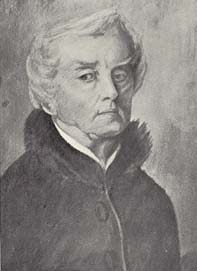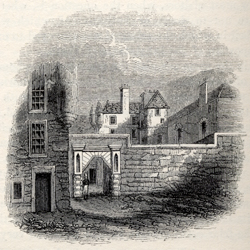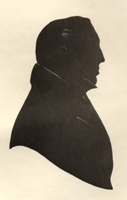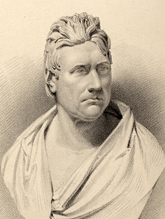| |
Home | Corson
Collection | Biography | Works | Image
Collection | Recent
Publications | Portraits | Correspondence | Forthcoming
Events | Links | E-Texts | Contact
John Morrison (1782-1853):
Land-Surveyor, Artist, and Poet
| John Morrison, the
son of a small farmer, was born in the Parish of Terregles,
Galloway, in 1782. As a boy, he attracted the interest of the
philanthropist Thomas Douglas, 5th Earl of Selkirk, who paid
for his education in Dumfries and Edinburgh. The Earl believed
that emigration to America was the only means to relieve the
poverty of many of his countrymen. He had Morrison trained
as a land-surveyor with a view to employing him on the settlements
that he would found on Prince Edward Island (1803) and the
Red River (1812-16). While in Edinburgh, however, Morrison
also studied painting under the landscape and portrait painter
Alexander Nasmyth, and was to remain torn between his profession
and his artistic ambitions throughout his working life. |

Self-portrait of John Morrison.
Reproduced by permission of the National Library of Scotland
|
On completing his studies, Morrison declined the offer of a position
on one of the Earl's settlements, much to his protector's disappointment.
He returned to his parents' farm of Fellend, near Ringford, Galloway,
and combined farming with land-surveying. In 1805, he came to the
attention of the great civil engineer Thomas Telford who was then
constructing a new bridge over the River Dee at nearby Tongland.
Telford engaged him to survey a projected railway from Glasgow
to Berwick, and subsequently, to work on numerous building projects
in Scotland, England and Wales.
| Morrison remained in Telford's employ for several
years, then acted as surveyor for John Rennie (portrayed right),
builder of Leeds Bridge, Waterloo Bridge, and Southwark Bridge,
and designer of London Bridge. Morrison was forced to give
up his post with Rennie in order to assist his ailing father.
He took a new lease at Fellend, and tried once again to combine
farming and surveying. So unsuccessful was he that, on his
father's death in 1818, he gladly transferred the lease to
his brother Thomas. He continued to survey land for the local
nobility and gentry, and to provide advice on laying out grounds.
Following a lengthy illness, however, he decided to renounce
surveying and to try his luck as a painter. |
|
In a letter to Scott dated 20 May 1819, Morrison describes how
he had returned to painting while illness excluded any more strenuous
activity. Now that he has fully recovered, he is resolved to 'abandon
a proffession [sic] that requires neither much taste nor imagination'
in favour of 'one which I have ever loved' (National Library of
Scotland MS 3890/100-01). The decision, Morrison insists, is not
as reckless as it might first appear. He has kept in his hand as
an artist throughout his professional life, and has been in the
habit of sketching and painting scenes observed when surveying.
In a further letter to Scott, dated 20 June 1820, he hopes that
his newly acquired skill as a lithographer will prove a useful
sideline (NLS MS 3891/67-68). The map of the Abbotsford estate
that Morrison drew up for Scott over the coming months was intended
to be his last piece of work before winding up his surveying business.
 Information
is scarce on the last thirty years of Morrison's life. Morrison's
own 'Reminiscences' published in Tait's Edinburgh Magazine (1843-44)
treat his dealings with Scott as the central episode of his life
and give little indication as to the success of his career change.
Alexander Trotter, in his East Galloway Sketches (1901)
relates that, having acquired a reputation for taking correct likenesses,
Morrison was invited to Liverpool in 1821 to paint portraits. He
failed to find steady work, however, and following a brief stay
in London where he befriended Sir Thomas Lawrence, he returned
to Galloway. It seems likely that he found himself forced once
again to combine painting and surveying. The 1851 Census of Kirkcudbrightshire
records his profession as 'civil engineer'. Trotter states that
'some of Morrison's sketches with his workmanship acknowledged
may be seen in the Abbotsford Edition of the Waverley Novels'.
However, only one small illustration for The Fair Maid of Perth (vol.
XI), a sketch of Gowrie House, Perth (see above right) is actually
attributed to Morrison. Information
is scarce on the last thirty years of Morrison's life. Morrison's
own 'Reminiscences' published in Tait's Edinburgh Magazine (1843-44)
treat his dealings with Scott as the central episode of his life
and give little indication as to the success of his career change.
Alexander Trotter, in his East Galloway Sketches (1901)
relates that, having acquired a reputation for taking correct likenesses,
Morrison was invited to Liverpool in 1821 to paint portraits. He
failed to find steady work, however, and following a brief stay
in London where he befriended Sir Thomas Lawrence, he returned
to Galloway. It seems likely that he found himself forced once
again to combine painting and surveying. The 1851 Census of Kirkcudbrightshire
records his profession as 'civil engineer'. Trotter states that
'some of Morrison's sketches with his workmanship acknowledged
may be seen in the Abbotsford Edition of the Waverley Novels'.
However, only one small illustration for The Fair Maid of Perth (vol.
XI), a sketch of Gowrie House, Perth (see above right) is actually
attributed to Morrison.
In 1832 he published a volume of poems (Poems of John Morrison)
which met with little success. Trotter suggests that the latter
part of his career was blighted by ostracism. Having offended his
former protector the Earl of Selkirk through a printed comment
on his aunt, he became persona non grata to the gentry.
The 1851 Census recalls that he lived alone with his unmarried
sister Helen, a school-mistress, and his niece Jane Melville, an
assistant teacher who became his heir. He died on 8 June 1853 and
is buried in the graveyard of the Old Priory Church, Tongland.
 Morrison
is briefly recalled in a number of memoirs of Galloway life in
the early nineteenth century. John Patterson's Memoir of Joseph
Train (1857) paints an unflattering picture of a man 'of dogmatic
assertions and high pretensions' (p. 58). Train (portrayed, right)
recalled dining with Sir Walter Scott and Patterson: 'A pair of
ptarmigans at table, which Sir Walter said he had received that
day as a present from the North, was a treat to everyone present'
except Morrison, 'who affirmed that these birds were as plentiful
as pigeons in Galloway.' 'So great was the vanity of Morrison',
Patterson continues, 'that even Sir Walter Scott was not allowed
to pass uncontradicted.' Sir
David Wilkie's recently completed
group-portrait The Abbotsford Family was exhibited to the company,
only for Morrison to declare that 'it was neither like Sir Walter
nor
any
of his
family'. Scott's daughter Anne archly replied, 'Oh, I forgot, Mr
Morrison, you are a painter yourself, and I have often heard it
remarked, that there is no friendship in trade, but I never saw
it verified before.' Perhaps, though, Train's acerbic recollections
are coloured by rivalry with Morrison, as both competed to supply
Scott with Galloway lore. (For Train's relations with Scott, see
the pages on Guy
Mannering and Old
Mortality.) Morrison
is briefly recalled in a number of memoirs of Galloway life in
the early nineteenth century. John Patterson's Memoir of Joseph
Train (1857) paints an unflattering picture of a man 'of dogmatic
assertions and high pretensions' (p. 58). Train (portrayed, right)
recalled dining with Sir Walter Scott and Patterson: 'A pair of
ptarmigans at table, which Sir Walter said he had received that
day as a present from the North, was a treat to everyone present'
except Morrison, 'who affirmed that these birds were as plentiful
as pigeons in Galloway.' 'So great was the vanity of Morrison',
Patterson continues, 'that even Sir Walter Scott was not allowed
to pass uncontradicted.' Sir
David Wilkie's recently completed
group-portrait The Abbotsford Family was exhibited to the company,
only for Morrison to declare that 'it was neither like Sir Walter
nor
any
of his
family'. Scott's daughter Anne archly replied, 'Oh, I forgot, Mr
Morrison, you are a painter yourself, and I have often heard it
remarked, that there is no friendship in trade, but I never saw
it verified before.' Perhaps, though, Train's acerbic recollections
are coloured by rivalry with Morrison, as both competed to supply
Scott with Galloway lore. (For Train's relations with Scott, see
the pages on Guy
Mannering and Old
Mortality.)
Malcolm M'L. Harper in his Rambles in Galloway (1896)
describes Morrison as 'one of Galloway's most original characters
in his day' (p. 115). 'In art', Harper regrets, 'he did not excel,
but as an engineer and land surveyor he was distinguished; and
had he possessed that steadiness of purpose necessary to success
in life, he might have risen to eminence in that walk'. He was
also 'somewhat of a humorist, and was famed for his pointed satirical
remarks'. Friends recalled him as 'a vain as well as a proud man'
who 'always endeavoured to leave the impression in company that
he was 'something more than common humanity' (p. 116). Trotter
acknowledges Morrison's reputation for vanity and condescension,
but has some sympathy for his plight, arguing that Galloway could
scarcely supply the quality of company to which he had been habituated
from an early age!
Morrison's dealings with Scott certainly bear witness to Morrison's
conceit and spirit of contradiction but also give a taste of the
(sometimes involuntary) humour that made him a favoured companion
of many of Scott's peers in the literary and artistic worlds.
Back to top
Back to Morrison Index
Back to
Biography Index
Last updated: 03-June-2005
© Edinburgh University Library
|
|



 Information
is scarce on the last thirty years of Morrison's life. Morrison's
own 'Reminiscences' published in Tait's Edinburgh Magazine (1843-44)
treat his dealings with Scott as the central episode of his life
and give little indication as to the success of his career change.
Alexander Trotter, in his East Galloway Sketches (1901)
relates that, having acquired a reputation for taking correct likenesses,
Morrison was invited to Liverpool in 1821 to paint portraits. He
failed to find steady work, however, and following a brief stay
in London where he befriended Sir Thomas Lawrence, he returned
to Galloway. It seems likely that he found himself forced once
again to combine painting and surveying. The 1851 Census of Kirkcudbrightshire
records his profession as 'civil engineer'. Trotter states that
'some of Morrison's sketches with his workmanship acknowledged
may be seen in the Abbotsford Edition of the Waverley Novels'.
However, only one small illustration for The Fair Maid of Perth (vol.
XI), a sketch of Gowrie House, Perth (see above right) is actually
attributed to Morrison.
Information
is scarce on the last thirty years of Morrison's life. Morrison's
own 'Reminiscences' published in Tait's Edinburgh Magazine (1843-44)
treat his dealings with Scott as the central episode of his life
and give little indication as to the success of his career change.
Alexander Trotter, in his East Galloway Sketches (1901)
relates that, having acquired a reputation for taking correct likenesses,
Morrison was invited to Liverpool in 1821 to paint portraits. He
failed to find steady work, however, and following a brief stay
in London where he befriended Sir Thomas Lawrence, he returned
to Galloway. It seems likely that he found himself forced once
again to combine painting and surveying. The 1851 Census of Kirkcudbrightshire
records his profession as 'civil engineer'. Trotter states that
'some of Morrison's sketches with his workmanship acknowledged
may be seen in the Abbotsford Edition of the Waverley Novels'.
However, only one small illustration for The Fair Maid of Perth (vol.
XI), a sketch of Gowrie House, Perth (see above right) is actually
attributed to Morrison. Morrison
is briefly recalled in a number of memoirs of Galloway life in
the early nineteenth century. John Patterson's Memoir of Joseph
Train (1857) paints an unflattering picture of a man 'of dogmatic
assertions and high pretensions' (p. 58). Train (portrayed, right)
recalled dining with Sir Walter Scott and Patterson: 'A pair of
ptarmigans at table, which Sir Walter said he had received that
day as a present from the North, was a treat to everyone present'
except Morrison, 'who affirmed that these birds were as plentiful
as pigeons in Galloway.' 'So great was the vanity of Morrison',
Patterson continues, 'that even Sir Walter Scott was not allowed
to pass uncontradicted.'
Morrison
is briefly recalled in a number of memoirs of Galloway life in
the early nineteenth century. John Patterson's Memoir of Joseph
Train (1857) paints an unflattering picture of a man 'of dogmatic
assertions and high pretensions' (p. 58). Train (portrayed, right)
recalled dining with Sir Walter Scott and Patterson: 'A pair of
ptarmigans at table, which Sir Walter said he had received that
day as a present from the North, was a treat to everyone present'
except Morrison, 'who affirmed that these birds were as plentiful
as pigeons in Galloway.' 'So great was the vanity of Morrison',
Patterson continues, 'that even Sir Walter Scott was not allowed
to pass uncontradicted.'